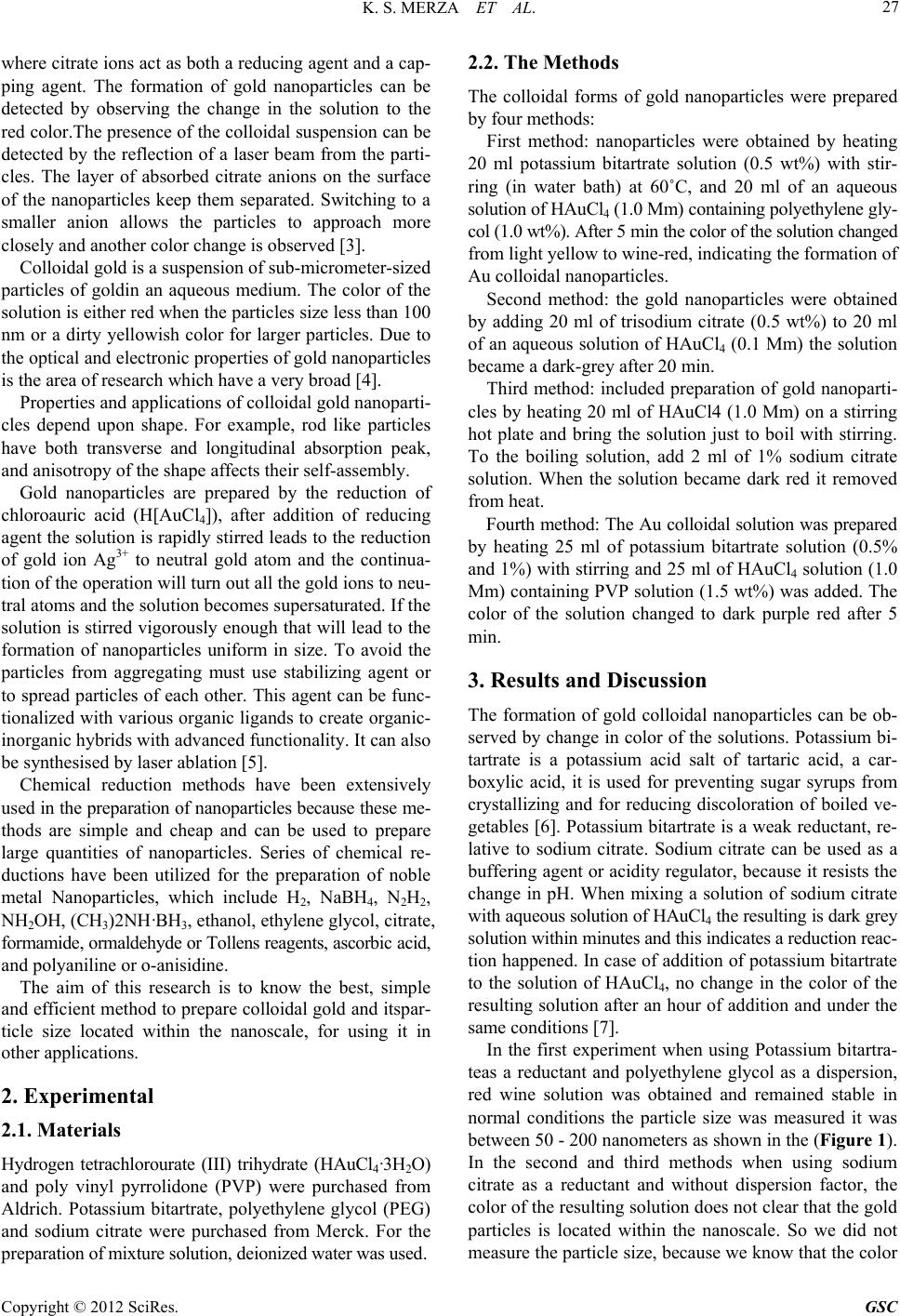
K. S. MERZA ET AL. 27
where citrate ions act as both a reducing agent and a cap-
ping agent. The formation of gold nanoparticles can be
detected by observing the change in the solution to the
red color.The presence of the colloidal suspension can be
detected by the reflection of a laser beam from the parti-
cles. The layer of absorbed citrate anions on the surface
of the nanoparticles keep them separated. Switching to a
smaller anion allows the particles to approach more
closely and another color change is observed [3].
Colloidal gold is a suspension of sub-micrometer-sized
particles of goldin an aqueous medium. The color of the
solution is either red when the particles size less than 100
nm or a dirty yellowish color for larger particles. Due to
the optical and electronic properties of gold nanoparticles
is the area of research which ha ve a very broad [4].
Properties and applications of co lloid al go ld nanoparti-
cles depend upon shape. For example, rod like particles
have both transverse and longitudinal absorption peak,
and anisotropy of the shape affects their self-assembly.
Gold nanoparticles are prepared by the reduction of
chloroauric acid (H[AuCl4]), after addition of reducing
agent the solu tion is rapidly stirred leads to the reduction
of gold ion Ag3+ to neutral gold atom and the continua-
tion of the operation will turn out all the go ld ions to neu-
tral atoms and the solution becomes supersaturated. If the
solution is stirred v igorously enough that will lead to the
formation of nanoparticles uniform in size. To avoid the
particles from aggregating must use stabilizing agent or
to spread particles of each other. This agent can be func-
tionalized with various organic ligands to create organic-
inorganic hybrids with advanced functionality. It can also
be synthesised by laser ablation [5].
Chemical reduction methods have been extensively
us ed in the preparation of nanoparticles because these me-
thods are simple and cheap and can be used to prepare
large quantities of nanoparticles. Series of chemical re-
ductions have been utilized for the preparation of noble
metal Nanoparticles, which include H2, NaBH4, N2H2,
NH2OH, (CH3)2NH·BH3, ethanol, ethylene glycol, citrate,
formamide, ormald ehyde or Tollens r eagents, ascorbic acid,
and polyaniline or o-anisidine.
The aim of this research is to know the best, simple
and efficient method to prepare colloid al gold and itspar-
ticle size located within the nanoscale, for using it in
other applications.
2. Experimental
2.1. Materials
Hydrogen tetrachlorourate (III) trihydrate (HAuCl4·3H2O)
and poly vinyl pyrrolidone (PVP) were purchased from
Aldrich. Potassium bitartrate, polyethylene glycol (PEG)
and sodium citrate were purchased from Merck. For the
preparation of mi xture solution, deionized water was used.
2.2. The Methods
The colloidal forms of gold nanoparticles were prepared
by four methods:
First method: nanoparticles were obtained by heating
20 ml potassium bitartrate solution (0.5 wt%) with stir-
ring (in water bath) at 60˚C, and 20 ml of an aqueous
solution of HAuCl4 (1.0 Mm) containing polyet hyl ene gly -
col (1.0 w t%). Af ter 5 min the color of th e so lution chan ged
from light yellow to wine-red, indicating the formation of
Au colloidal nanoparticles.
Second method: the gold nanoparticles were obtained
by adding 20 ml of trisodium citrate (0.5 wt%) to 20 ml
of an aqueous solution of HAuCl4 (0.1 Mm) the solution
became a dark-grey after 20 min.
Third method: included preparation of gold nanoparti-
cles by heating 20 ml of HAuCl4 (1.0 Mm) on a stirring
hot plate and bring the solution just to boil with stirring.
To the boiling solution, add 2 ml of 1% sodium citrate
solution. When the solution became dark red it removed
from heat.
Fourth method: The Au colloidal solution was prepared
by heating 25 ml of potassium bitartrate solution (0.5%
and 1%) with stirring and 25 ml of HAuCl4 solution (1.0
Mm) containing PVP solution (1.5 wt%) was added. The
color of the solution changed to dark purple red after 5
min.
3. Results and Discussion
The formation of gold colloidal nanoparticles can be ob-
served by change in color of the solutions. Potassium bi-
tartrate is a potassium acid salt of tartaric acid, a car-
boxylic acid, it is used for preventing sugar syrups from
crystallizing and for reducing discoloration of boiled ve-
getables [6]. Potassium bitartrate is a weak reductant, re-
lative to sodium citrate. Sodium citrate can be used as a
buffering agent or acid ity regulator, because it resists the
change in pH. When mixing a solution of sodium citrate
with aqueous solution of HAuCl4 the resulting is dark grey
solution within minutes and this indicates a reduction reac-
tion happened. In case of addition of potassium bitartrate
to the solution of HAuCl4, no change in the color of the
resulting solution after an hour of addition and under the
same conditions [7].
In the first experiment when using Potassium bitartra-
teas a reductant and polyethylene glycol as a dispersion,
red wine solution was obtained and remained stable in
normal conditions the particle size was measured it was
between 50 - 200 nanometers as shown in the (Figure 1).
In the second and third methods when using sodium
citrate as a reductant and without dispersion factor, the
color of the resultin g solution d oes not clear th at the go ld
particles is located within the nanoscale. So we did not
measure the particle size, because we know that the color
Copyright © 2012 SciRes. GSC